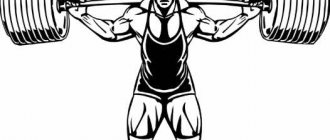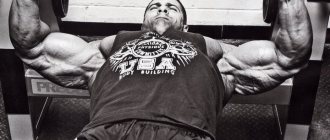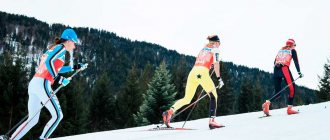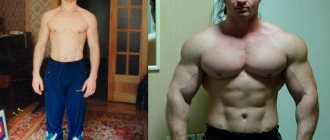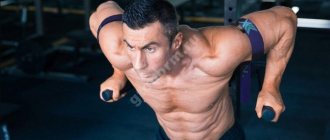The simple, but at the same time complex “Powerlifting” program of Boris Ivanovich Sheiko is distinguished by its severity and limited diet. This book provides answers to all questions not only of young, but also of experienced athletes. The author is an authority on powerlifting, although not everyone understands or follows his program.
The main advantage is that there are exercises for different levels of training of athletes, so that absolutely anyone can choose the most suitable regime for themselves. Basic rules immediately make it clear to a person what kind of load awaits him in the future. Therefore, the author himself and other experienced athletes strongly recommend reading the book from beginning to end, without avoiding the introduction and conclusion. Otherwise, the program will not be implemented at a sufficient level, which is why it will not be possible to achieve the desired result.
Boris Ivanovich Sheiko
Boris Sheiko rightfully received the title of Honored Coach of the USSR in powerlifting. “Powerlifting” is his training method for dischargers, which helps not only physically, but also mentally get in shape for upcoming competitions. In total, several books have been published where an experienced athlete and coach shares his own unique methods of planning exercises for athletes.
Russian cycle for powerlifting
- Date: 2015-09-20
- Training program
- : 8
The Russian powerlifting cycle is a two-month training program consisting of only three basic exercises: squats, bench presses and deadlifts. It is designed for three workouts per week. The Russian cycle is based on periodization based on the principle of medium-heavy training in squats and bench press, i.e. from 80% of the one-time maximum and above. And linear periodization in the deadlift - 4 weeks of training volume and 5 weeks of training weights. The weights in the table do not include warm-up. A warm-up is a must!
The first workout is a medium squat, heavy bench press.
The second workout is deadlift.
The third workout is a heavy squat, medium bench press.
Click on the picture to enlarge
DOWNLOAD Russian cycle 9 weeks.
The cycle is designed for advanced athletes (“discharge athletes”).
There is an opinion that from the Russian cycle they get an increase mainly in squats. I think that in order to increase the bench press, it is worth putting it before squats in the “first” workouts.
Also check out Professor Verkhoshansky's cycle and my strength cycle for the bench press.
Powerlifting Sheiko
This program provides for unloading of athletes, during which the intensity of the loads is slightly reduced. Sheiko's powerlifting training operates according to the student system, that is, if nothing has been imprinted in your head over the past semester, then you will not be able to learn it in a couple of days. This methodology is constructed in exactly the same way: if over a certain period of time an athlete was unable to accumulate the strength to win a competition, then the last couple of weeks will not correct this.
In fact, trying to achieve the necessary results in a few days after a long rest will only make the situation worse and deprive the already small amount of energy that will have to be restored again. The moment when the athlete truly reaches the very peak of his own physical fitness should be clearly defined and held. A coach can best help you in this matter. After all, it is he who is obliged to convey to his ward the value of all the efforts spent and direct him on the right path.
Hard hardcore
This means, of course, working hard to overcome the impossible. This is especially true for arresters and kms. After all, they are at the peak of their form, and they want to become even more perfect. You can work out in the gym three to four times a week.
The exercises should be distributed as follows. On the first day, the emphasis is on squats. Press no more than once. Afterwards rest, but be active. That is, a light jog or walk. It’s even better to combine it with a visit to the pool, bathhouse, sauna. After the lesson they are escorted in this order. Emphasis on the bench press. Traction between sets.
At the end of the week, repetitions increase to 6 times. The warm-up involves a weight that reaches 60% of the working weight. It is important to remember to write a plan and create a menu. Monitoring your diet will ensure normal condition and rest for the entire body.
Basic and additional exercises
The classification of physical exercises is a specific system of their distribution into clear groups, as well as subgroups. This distribution occurs solely on the basis of existing characteristics. The theory of physical education and Sheiko’s “Powerlifting” distinguish three main groups of exercises for absolutely any sport:
- Competitive.
- Specially preparatory.
- General training.
The first group includes exercises that are included in the competition program and are used during training. The competition ones include the main ones: squat with a barbell, bench press (horizontal position), deadlift.
The second group consists of exercises that are mainly aimed only at studying and then improving individual elements taken from the techniques of the competitive group. In addition, thanks to the special training system, athletes have the opportunity to develop their own physical qualities, which is very important for a professional athlete. Strength, endurance, flexibility and other qualities should always be present in a worthy athlete. The program includes lead-up exercises: squats, bench presses, and deadlifts.
It should be noted that any exercise is considered a special preparatory exercise only if it contains factors quite similar to the competitive one.
Among other things, the second group is divided into introductory and developmental exercises, depending on the focus. The former contribute to the development of the form and technique of movements, while the latter are directly aimed at developing those very qualities of an athlete. It is worth remembering that developers have a local impact.
Exercises from the third group are used to increase the overall level of physical fitness of the athlete, as well as to develop individual muscle groups. The list of general preparatory exercises includes: exercises with a barbell, acrobatic, on simulators, gymnastics, with weights, shock absorbers and dumbbells. All of them help the athlete to develop diversified. In terms of technical parameters, this group has significant differences from the previous two. Competitive and special preparatory exercises are considered to be the basis, and general preparatory exercises are only an addition. It follows from this that they should be analyzed and adjusted to one’s own strengths in different ways.
Powerlifting programs
Powerlifting programs from famous coaches and athletes. All training programs are functional and effective, but depending on the physical characteristics of each person, not every lifting program may be right for you.
Choose and try to find exactly the powerlifting program that will give you the greatest increase in triathlon. If you are interested in the bench press, then see bench press programs here.
You can find many different powerlifting programs in books.
Sheiko B.I. cycles in Excel
Very conveniently designed powerlifting programs by Boris Ivanovich Sheiko, you just plug in your performance in the exercises and all the weights are recalculated for you.
Self-calculating cycles by Dmitry Golovinsky in Excel
Dmitry Golovinsky - MSM WPC/AWPC of Ukraine, record holder and world champion in powerlifting and bench press, national category judge.
Here are self-calculating powerlifting cycles for athletes of various levels of preparedness from beginners and advanced athletes to intermediate athletes. You will find a detailed description of cycles and their use on Dmitry’s website.
Here are some more programs and loops in Excel
List of the best programs
I advise you to definitely read an excerpt from the book “Body of Tips on Explosive Training.”
Train according to the program, but don't be afraid of workarounds
You need a program designed to help you achieve your training goals. The difference is that each program has its own strengths and weaknesses. Time and experience are the best teachers. Find out how you can tailor the program to suit you. For beginners, I would advise using proven powerlifting training programs. They are not as effective as custom-made ones, but they are much better than those that you can come up with without experience. That's why they are described at the beginning - they serve as a starting point.
At intermediate and advanced levels, you need to think of your program like driving a car on the highway. You must go in the right direction, no matter who tells you what. The difference is that you need to read the signs. On any long journey there are slowdowns, stops, and detours. As travelers, we expect this, but we still get upset when we come across them. It's part of the game. There are things that can ruin the training process. Things may not go as planned and you may find a workaround. In fact, if you find yourself running ahead of schedule and everything is going smoothly, be on guard.
Get your ass off!
You read about the dynamic and maximum effort method. The problem is that you started training 6 months ago and you look like a stick. However, you feel that this is the best way to train strength and you have heard many others say the same thing. You read all the articles, but missed the point.
Yes, you can use these techniques, but only when they are inserted into your program based on your weaknesses.
What is your weakness? Hips? Triceps? Or maybe the whole body is just weak? A beginner does not need to start with advanced training methods. He needs to build a strong foundation with basic movements.
It's not easy to overcome
Are you worried that progress is not too fast? You know, I've never seen anyone worry about progressing too quickly. There are those who can gain strength just by looking at the weights. These guys can train once a week and they all grow like weeds. But it's not me, and I'm willing to bet it's not you.
Work to get results. The road is never easy and it can take several years to gain a few pounds. This is not easy, even for those who progress quickly. Sooner or later this happens to everyone. If you can't handle this, get out of the room.
With fanatical faith anything is possible
If you want to achieve results, you must have fanatical faith in your own ability to succeed. The best example, I think, is Matt Krozaleski.
Just a few weeks before the Arnold Classic, Matt noticed that his knee was hurting. The condition worsened.
“I think tomorrow will be better,” he said Monday.
"It's really swollen," he said Tuesday.
On Wednesday he said: “Guys, I can’t get out of my chair. My knee hurts so much that I can't touch it. I have no idea what happened."
On Thursday it was even worse: “I can’t walk without crutches. The knee does not bend. The pain is unbearable."
On Friday he was beside himself: “I went to the doctors, but they don’t know what happened.” Arnold Classic is in two weeks. He growled that this wasn't what he was "busting his ass for." “I'm going to convince myself that I'm getting better and the knee is healing,” he said.
At the tournament he squatted 440 kg, despite the fact that two weeks ago he was on crutches. Such is the power of faith.
You can download this and other books here.
Videos on powerlifting training programs
Source: ZhimLezha.ru
Bench press
This exercise is universal, as it is involved in two main groups. As a competitive exercise, it is performed exclusively on a horizontal bench. The barbell is clearly fixed in straightened arms and, at the judge’s command, it must be lowered to the chest, make a visible pause, and then press it onto straightened arms.
As a special preparatory exercise, the bench press can be performed both on a horizontal and on an inclined bench. It can also be done not only with your head up, but also on a reverse incline bench. In this group, dumbbells can replace the barbell.
Powerlifting - strength training program
The main feature that distinguishes powerlifting from other related sports is the absolute priority of developing strength indicators over other functional capabilities of the human body. Accordingly, the main goal facing any powerlifter is to lift the maximum possible weight in one repetition in one of the 3 classic weightlifting basic exercises (remember, these include the bench press, squats and deadlifts). Once upon a time, the list of competitive disciplines also included the military standing barbell press, but a large number of injuries among competing athletes led to the removal of this exercise from the list for competitions.
Lifting maximum weight in powerlifting requires an athlete to work on developing their strength. Drawing up training programs for a powerlifter has its own specifics, which distinguishes it from training programs for other strength sports.
This material will discuss how to create a training program to obtain the greatest results in the development of strength and power indicators, which training program is best suited for powerlifting, the basic principles of training for strength development, issues of periodization and diet and recovery.
Powerlifting - what is it, its differences
Powerlifting or powerlifting is a sport. Athletes competing in powerlifting competitions set their main goal to overcome the resistance of the maximum weight for the athlete. Raising maximum weights occurs in three exercises; the competitive results of weightlifters of the same weight category are compared with each other and assessed in total based on the weights taken in all 3 exercises.
Bodybuilding is aimed primarily at developing muscle mass, relief and body proportions, and does not require high functionality, while powerlifting is focused on constantly increasing strength results.
Powerlifters do not need to develop endurance, unlike track and field athletes, as well as athletes competing in the CrossFit discipline.
Basic Training Principles for Strength Development
Powerlifting training is exclusively strength-based. Which means a periodic but regular increase in the intensity of training and an increase in the volume of the total load produced in the form of weights lifted by the athlete.
In practice, the training regimen looks like this: Powerlifters work on one or two multi-joint competition movements each workout, in 4-6 sets, with a low number of repetitions (2-5 repetitions).
This is another difference from bodybuilding, in which athletes most often work out only one or two muscle groups in one workout, performing 3-4 working approaches for an average number of repetitions (8-15).
Creating a powerlifting training program
Training programs for powerlifting should be compiled by experienced athletes who understand the specifics of approaches to strength training, and also understand the need for an individual approach to the selection of a training program, depending on his personal strength qualities, experience, as well as the anatomy and physiology of the athlete.
Every novice athlete who decides to engage in power lifting is recommended to first master the basics of the correct technique for performing the classic three basic exercises; it would not be a bad idea to visit any good powerlifting section/school. Work with a personal mentor at the initial stage of training, who will explain the main principles of powerlifting and help you begin targeted, effective training as quickly as possible.
The “golden three” of powerlifting are the squat, bench press and deadlift. These are classic basic exercises. Without their implementation, it is impossible to achieve significant development of strength and impressive muscle volumes.
In addition, a powerlifter's program should have a place for auxiliary exercises designed to work on weak points when performing exercises that limit overall performance. Such movements include hyperextension, wide-grip pull-ups, leg press in a machine, bending over with a barbell, as well as dips, etc.
A powerlifter needs more rest time between sets than a bodybuilder. If in bodybuilding it averages 1-2 minutes, then in powerlifting, due to the specifics of the heavy load, you will need up to 5 minutes of rest or more before performing the next approach.
Number of workouts per week: since heavy loads require quite a lot of time for muscle recovery, it is recommended to stop at 3 (maximum 4) visits to the gym per week.
Periodization of loads in powerlifting
Training in powerlifting involves a regular progression of loads, but it will not be possible to constantly linearly increase the weights on the bar from session to session, because such a technique will certainly cause the athlete a phenomenon called overtraining syndrome and can lead to a loss of desire to train at all. To prevent this, it is necessary to use the principle of load periodization.
The principle comes down to alternating loads, namely, heavy exercises are replaced by fairly light ones, and then light ones are replaced by workouts with a medium load.
This periodization of loads can be applied both within one week and over the course of a month, i.e. microcycles and mesocycles are used.
In practice it looks like this:
- first week (heavy) – the athlete performs a bench press with a weight of 100 kg in 5 sets of 5 repetitions,
- second week (easy) – 60 kg bench press in 3 sets of 8 repetitions,
- third week (medium) – 80 kg bench press in 4 sets of 6 repetitions,
As already noted, the training program used in powerlifting is tailored to each athlete individually. An experienced trainer leaves it based on your personal characteristics, experience and the results of the “pass” (read about it below).
It is most common to create such programs for a 3-month period, since their preparation for longer periods will lead to the body becoming accustomed to the load and slowing down the rate of your progress. Therefore, after training for three months, it is necessary to re-do the drilling and make changes to the training plan.
Most strength training programs in powerlifting are designed for 3 workouts per week. In the program, there is always a bench workout between the squat day and the deadlift day. Since the legs are heavily involved in both squats and deadlifts, they should be given more time to recover, so a bench press is always placed between the squat and deadlift. Sometimes, on one training day, 2 basic exercises are performed, but in this case, one of them is performed with large weights, and the other with small ones.
Walking in powerlifting
“Passing” in powerlifting is the definition of the maximum weight in each of the three competitive lifts that an athlete can lift. Competently drawing up a training program requires mandatory drilling. A feature of training programs in powerlifting is the use of a percentage of one repetition maximum (1 RM) that the athlete lifts.
Based on this principle, 3 types of training are distinguished: light, medium and heavy, in which work is performed with various weights of weights (in light training, the load is 50% of 1 rep.M., in medium - 65%, and in heavy - 90% ).
It is possible to perform powerlifting exercises on all muscle groups in one day, but it is necessary to take a long break between approaches. For example, first perform a squat, then a barbell press, and finally a deadlift, but a prerequisite for progress is a thorough warm-up and warming up of the muscles before each super-heavy approach.
It is necessary to carry out penetration by gradually increasing the weight on the bar between approaches, initially it increases by 10 - 20 kg, in the last approaches up to 2-3 kg.
The walk involves doing it with a partner. Since the goal is to find the maximum weight, the last set should be accompanied by muscle failure and the inability to lift the weight on your own. At this moment you will need a partner, otherwise you will simply be crushed during the bench press or squat.
Examples of Powerlifting Training Programs
Examples of training programs based on the principle of periodization on a weekly cycle, with three workouts per week:
Training program 1
First day:
| Exercise | Approaches | Repetitions |
| 1. Bench press (80% of 1 R.M.) | 5 | 5 |
| 2. Squats with a barbell on the shoulders (60% of 1 R.M.) | 5 | 5 |
| 3. French bench press with a horizontal barbell. bench | 3-4 | 8 |
Second day:
| Exercise | Approaches | Repetitions |
| 1. Deadlift (80% of 1 rep.m.) | 5 | 5 |
| 2. Hyperextension | 3-4 | 10-12 |
| 3. Standing biceps curl | 3-4 | 8-10 |
The third day:
| Exercise | Approaches | Repetitions |
| 1. Bench press (60% of 1 R.M.) | 5 | 5 |
| 2. Squats with a barbell on the shoulders (80% of 1 R.M.) | 3-4 | 10-12 |
| 3. Swing dumbbells to the sides (or bending over/in front of you) | 3-4 | 10 |
As can be seen from the given lesson plans, the working weights depend on the results of driving with maximum weights. This is only a general method of execution; a specific cycle is compiled with the help of an experienced trainer, especially in relation to novice athletes.
Training program 2
Day 1 (pectoral muscles):
| Exercise | Approaches | Repetitions |
| 1. Squats with a barbell on the shoulders (60% of 1 R.M.) | 5 | 5 |
| 1. Bench press (75% of 1 R.M.) | 5 | 5 |
| 3. Standing barbell press (military press) | 5 | 8-10 |
Day 2 (back):
| Exercise | Approaches | Repetitions |
| 1. Deadlift (75% of 1 rep.m.) | 5 | 5 |
| 2. Shrugs with a barbell | 5 | 16-20 |
| 3. Close grip barbell press | 5 | 8-10 |
Day 3 (quadriceps and calves):
| Exercise | Approaches | Repetitions |
| 1. Squats with a barbell on the shoulders (75% of 1 R.M.) | 5 | 5 |
| 2. Calf raises | 3 | 18-20 |
| 3. Barbell row to the chin | 4 | 8-10 |
The duration of this training program should not be longer than 3 months. Training takes place three times a week, with the first week the load being 75% of your repeated maximum, which was determined using walking. The second 7 days the work is performed at 80%, and then the load increases by 2.5% with each subsequent week. As already mentioned, after completing the 3-month cycle, this program must be changed by performing the penetration again.
Training program 3
Day 1:
| Exercise | Approaches | Repetitions |
| 1. Squats with a barbell on the shoulders (75-85% of 1 R.M.) | 5 | 5 |
| 2. Bench press (65-75% of 1 R.M.) | 5 | 16-20 |
Day 2:
| Exercise | Approaches | Repetitions |
| 1. Deadlift (75-80% of 1 rep.m.) | 3-4 | 5 |
| 2. Bent-over barbell row | 3 | 6-8 |
Day 3:
| Exercise | Approaches | Repetitions |
| 1. Squats with a barbell on the shoulders (55-65% of 1 R.M.) | 5 | 5 |
| 2. Bench press (75-85% of 1 R.M.) | 5 | 5 |
| 3. Close grip barbell press | 3-4 | 8-10 |
Classes also take place three times a week. This training program is well suited for beginners in powerlifting. If after performing heavy basic movements there is still strength left, then after them you can add one or two isolating ones to work individual muscles, but you can completely do without using them.
How to Avoid Injuries in Powerlifting
When starting powerlifting classes, do not try to learn the technique of performing heavy, complex movements on your own; seek help from a coach or an experienced athlete; this will reduce your time and also reduce the risk of injury tenfold.
With the correct movement technique, the likelihood of injury (sprains, bruises, as well as ruptures of muscles, ligaments and tendons) is minimized.
Strength increases gradually, do not chase the weights on the bar, do everything according to plan and in a timely manner.
To support your lower back and spine when deadlifting and squatting, use a weightlifting belt. To protect your knees, you can use elastic bandages, bandages or special knee pads.
Powerlifter training program - Pavel Badyrov:
Share: Source: power-body.ru
This is interesting: Training program for powerlifting
Sample training plan
Each person can try to perform the basic exercises that Sheiko’s “Powerlifting” program provides.
Workout 1
| № | Exercises | Number of approaches | Weight, % | Repetitions |
| 1 | Bench press | 1; 2; 2; 4 | 50; 60; 70;75 | 5; 4; 3; 3 |
| 2 | Squats | 1; 2; 5 | 50; 60; 70 | 5; 5; 5 |
| 3 | Bench press | 1; 2; 4 | 50; 60; 65 | 6; 6; 6 |
| 4 | Dumbbell raises | 3 | 5 |
Workout 2
| № | Exercises | Number of approaches | Weight, % | Repetitions |
| 1 | Deadlift | 1; 2; 2; 4 | 50; 60; 70; 75 | 5; 5; 4; 3 |
| 2 | Bench press at an angle | 4; 6 | 4 | |
| 3 | Dips | 4; 5 | 4 | |
| 4 | Ab crunches | 3 | Maximum |
Example of a weight table, kg
| Exercise | 100% (RM) | 85% | 80% | 75% | 70% | 65% | 60% | 55% | 50% |
| Bench press | 100 | 85 | 80 | 75 | 70 | 65 | 60 | 55 | 50 |
| Squats | 110 | 94 | 88 | 83 | 77 | 72 | 66 | 61 | 55 |
| Deadlift | 115 | 98 | 92 | 86 | 81 | 75 | 69 | 63 | 58 |
The one-time maximum remains constant throughout the entire cycle; overestimation of the RM is unacceptable. A new cycle begins with recalculation of the PM; after every 3 cycles, penetration can be performed.
Rest time between hikes and exercises is 2-4 minutes.
Positive feedback about the program
Like any book, Sheiko’s Powerlifting method has reader reviews. Fortunately, there are much more positive opinions from beginners and professional athletes than negative ones.
Many people note that this book helps to learn information about muscles that not only athletes should know for sure. This technique describes the training in detail, as well as additional material. In addition, each exercise is illustrated, and a person will be able to perform them correctly.
Another important fact is that the book describes the methods of world athletes. Many novice athletes strive to follow the example of those who have achieved considerable success in sports. Therefore, this section is not superfluous in the book. Sheiko's Powerlifting program attracts attention with excellent content that is understandable to everyone.
It should be noted that there are quite a large number of readers who became interested in powerlifting and started playing sports after reading it.
Preparation for performances
The important thing to remember here is the required minimums. First you have to calculate everything for three months. Rest on Tuesday and Thursday. For warming up, a weight equal to half the working weight is suitable. Everything is calculated only from real results.
Fast pumping
A special feature of this section in the Sheiko training program is the presence of lead-in exercises. They resemble the main ones, but are reduced in the number of repetitions and loads.
It resembles a kind of ladder, which does not allow you to overestimate your capabilities. This applies to beginners and those who have not visited the gym for a long time.
Author's shortcomings
As mentioned above, Sheiko’s powerlifting training plan has virtually no negative reviews. For arresters, he presents a good manual with decent recommendations. The only thing that athletes note is too weak or too strong loads. But we should not forget that for each person the additional weight and number of repetitions must be calculated separately. Therefore, the author did not notice any particular shortcomings, and all the material presented in the program motivates athletes to new victories. In Sheiko’s book “Powerlifting,” absolutely anyone with desire and willpower can progress from beginner to master.
Bench press technique
To begin with, you must learn that the shoulder blades need to be pulled back and then down, thereby you will already have something like a “lifter’s” bridge. It is this position that allows you to correctly press the barbell while lying down , and it is true for any chest presses and flyes. As soon as the shoulders move forward, this indicates that the triceps and the anterior shoulder band have begun to work. The grip is wide and adjusts to you. Personally, my height is 180 and I grip the bar with my middle fingers at the level of the “incisors” (the bar is naturally Olympic). To make it clear, I showed their approximate location in Fig. 1. That is, I don’t have an extremely wide grip.
You must stand firmly on your feet. Ideally, when a good bridge is achieved, the legs stand tightly on their toes, approximately under the asses..., oh, excuse me, under the buttocks. As a result, you can stick a hand or even two under your lower back, if your flexibility allows you to do so. At first, the lower back will hurt from the bridge, but then it will go away. Improve your flexibility at the same time. The bar in the starting position is opposite the eyes. It won’t be possible to take a heavy barbell in this position on your own, because you will have to let go of your shoulder blades, which, as we remember, should be pulled back and down. Therefore, your partner should always bring the barbell to the starting position. Lower the bar below your nipples, i.e. to the highest point (relative to the bench), and when the barbell is pressed to the end, it should be approximately at neck level. As you can see, it turns out that the ascent trajectory does not look like this: |, but like this /. And lastly: you must PURPOSELY develop the speed of the bench press ! Those. lower the bar slowly, but press it as quickly as possible! This is what you need to focus on. Once you master the above technique, believe me, you will already be benching more. For clarity, I will give another figure. 2.
I hope I explained it clearly, because writing about technology is difficult, it’s easier to show. In principle, there are plans to create video tutorials, we’ll see how it goes...
And now the actual program that will help you squeeze out more. Before you begin, do not forget that there are actually many nuances in the bench press and you need to constantly hone the technique that I told you. You constantly need to develop explosive speed in the positive phase of the exercise. Now about the program. Boris Ivanovich Sheiko’s program , taken from his book: “Powerlifting ,” which is designed for training elite athletes for 2 months. It really works!
More information on the topic: how to increase arm strength and triceps exercises with dumbbells.
